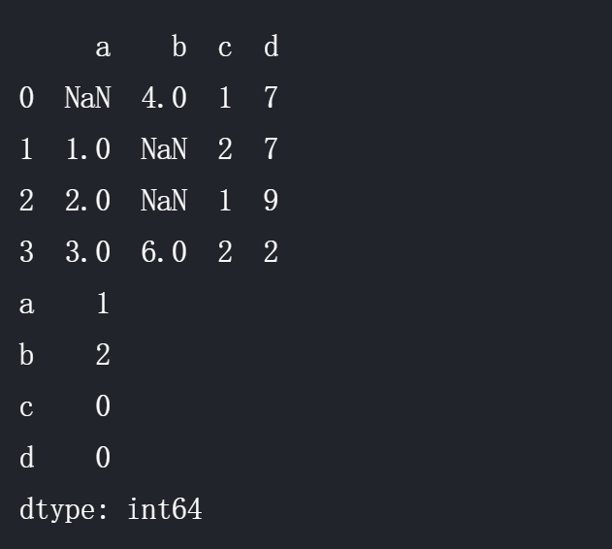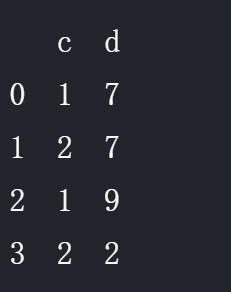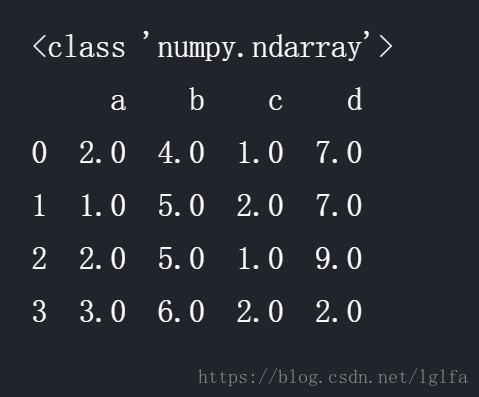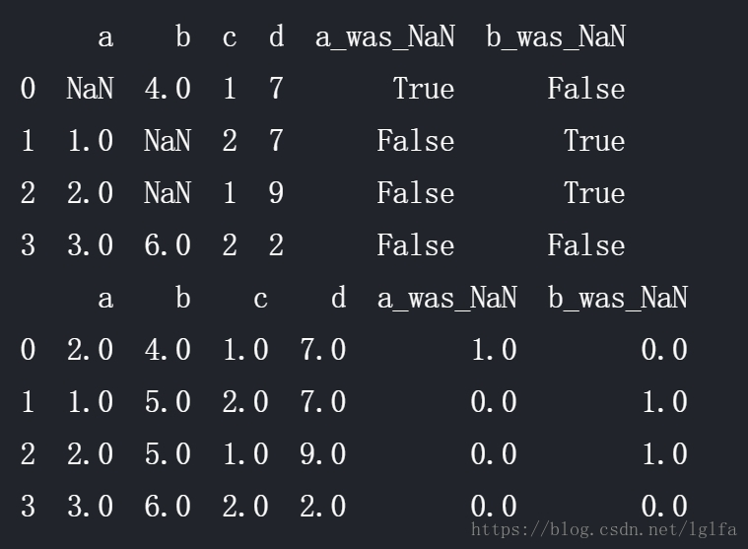Python如何优雅地处理NaN
发布时间:2019-08-27 08:02:17编辑:auto阅读(2236)
背景
很多数据不可避免的会遗失掉,或者采集的时候采集对象不愿意透露,这就造成了很多NaN(Not a Number)的出现。这些NaN会造成大部分模型运行出错,所以对NaN的处理很有必要。
方法
1、简单粗暴地去掉
有如下dataframe,先用df.isnull().sum()检查下哪一列有多少NaN:
import pandas as pd
df = pd.DataFrame({'a':[None,1,2,3],'b':[4,None,None,6],'c':[1,2,1,2],'d':[7,7,9,2]})
print (df)
print (df.isnull().sum())输出:

将含有NaN的列(columns)去掉:
data_without_NaN =df.dropna(axis=1)
print (data_without_NaN)输出:

2、遗失值插补法
很多时候直接删掉列会损失很多有价值的数据,不利于模型的训练。所以可以考虑将NaN替换成某些数,显然不能随随便便替换,有人喜欢替换成0,往往会画蛇添足。譬如调查工资收入与学历高低的关系,有的人不想透露工资水平,但如果给这些NaN设置为0很显然会失真。所以Python有个Imputation(插补)的方法,其中 的算法不细究。代码如下:
from sklearn.preprocessing import Imputer
my_imputer = Imputer()
data_imputed = my_imputer.fit_transform(df)
print (type(data_imputed))
# array转换成df
df_data_imputed = pd.DataFrame(data_imputed,columns=df.columns)
print (df_data_imputed)输出:

可以看出,这里大概是用平均值进行了替换。
3、推广的遗失值插补法
这个推广的思想是NaN本身具有一定数据价值,譬如不爱说自己工资的被调查者是不是有什么共性,这个时候就不能简单的只用上面的插补法,要增加几列,将NaN的情况记录下来作为新的数据:
# 先复制一份爱怎么玩怎么玩
new_data = df.copy()
# 增加有NaN的布尔列(True/False)
cols_with_missing = (col for col in new_data.columns
if new_data[col].isnull().any())
for col in cols_with_missing:
new_data[col + '_was_NaN'] = new_data[col].isnull()
print (new_data)
# Imputation
my_imputer = Imputer()
new_data_imputed = my_imputer.fit_transform(new_data)
# array转换成df
df_new_data_imputed = pd.DataFrame(new_data_imputed,columns=new_data.columns)
print (df_new_data_imputed)输出:

上一篇: Python字符串的基本用法总结
下一篇: 在CentOS7.0上安装Python3
- openvpn linux客户端使用
51703
- H3C基本命令大全
51361
- openvpn windows客户端使用
41798
- H3C IRF原理及 配置
38568
- Python exit()函数
33042
- openvpn mac客户端使用
30064
- python全系列官方中文文档
28728
- python 获取网卡实时流量
23724
- 1.常用turtle功能函数
23641
- python 获取Linux和Windows硬件信息
22004
- Python搭建一个RAG系统(分片/检索/召回/重排序/生成)
2212°
- Browser-use:智能浏览器自动化(Web-Agent)
2904°
- 使用 LangChain 实现本地 Agent
2426°
- 使用 LangChain 构建本地 RAG 应用
2369°
- 使用LLaMA-Factory微调大模型的function calling能力
2938°
- 复现一个简单Agent系统
2369°
- LLaMA Factory-Lora微调实现声控语音多轮问答对话-1
3168°
- LLaMA Factory微调后的模型合并导出和部署-4
5220°
- LLaMA Factory微调模型的各种参数怎么设置-3
5031°
- LLaMA Factory构建高质量数据集-2
3595°
- 姓名:Run
- 职业:谜
- 邮箱:383697894@qq.com
- 定位:上海 · 松江
